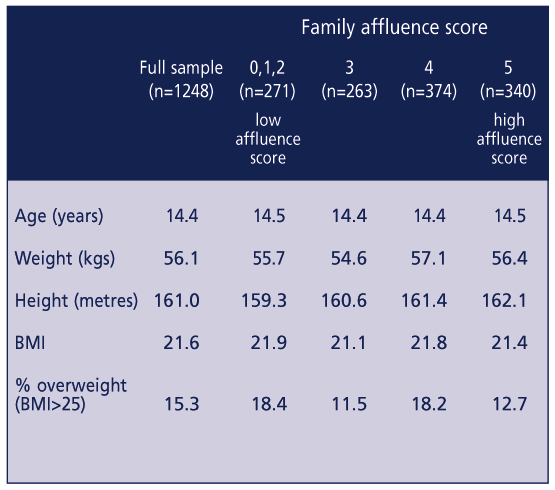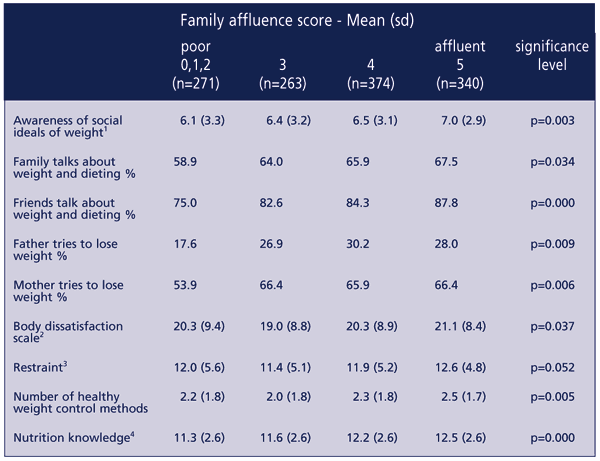 |
Close
window to return
|
Issue 7, April
2001, pp.6-7.
Attitudes to body shape and dieting in adolescent girls
Jane Wardle
Introduction
Among women, there is a marked socio-economic gradient in obesity in most
older industrial countries. In the UK, women from social class V have
almost twice the risk of obesity of women in social class I.(1) The gradient
by socio-economic status (SES) appears to be less pronounced in men and
children, but there is evidence to suggest that it is becoming more like
the female gradient over time.
Among the factors which may contribute to the socio-economic gradient
in obesity is dietary restraint, i.e. voluntary efforts at weight control.
Levels of dietary restraint are higher in higher SES women; and they also
use more 'healthy' weight control practices such as decreasing fat and
increasing exercise. Why should there be SES differences in weight control
practices? Differences in attitudes to diet, weight and body shape are
one possibility. Contemporary Western cultures idealise thinness, especially
for women, and it has been suggested that these pressures could be stronger
in higher SES women.
Exploring possible differences in attitudes and practices regarding body
shape and dieting is a complex task. A major difficulty is that, because
dieting is itself usually triggered by feeling overweight, it is difficult
to use cross-sectional data to explore the contribution of dieting to
weight differentials. One option is therefore to examine differences in
dieting attitudes and practices before the development of a significant
gradient in weight. Childhood and adolescence provides the opportunity
to address this issue.(2)
As one part of our project, we examined attitudes to body shape and weight
control practices in relation to social background in adolescent girls.
The social gradient in weight was predicted to be minimal at this age,
allowing us to examine SES differences in weight-related attitudes without
the complications of differential experience of overweight.
Methods
We conducted a school-based survey of girls aged 13-15 years (n=1248).
Seven schools in Wirral and West Cheshire were selected to represent a
range of deprivation levels, based on the proportion of children receiving
free school meals in each school. All children attending school on the
days of data collection took part, so participation levels were extremely
high. Socio-economic circumstances were measured through a 'family affluence
scale' (FAS), based on a range of indicators, including housing tenure,
car access, ownership of computer, and the option of free school meals.
The FAS, based on ones used in other studies of young people,(3) had high
completion rates and good validity.
We used and adapted well-validated questionnaires to measure social ideals
of appearance, body dissatisfaction, dietary restraint and nutritional
knowledge. We also developed new measures, including a BMI-calibrated
figure-rating scale, which consisted of a series of 12 line drawings of
female figures adapted from photographs of young women of known BMI (body
mass index). Participants were asked to identify the figure which they
thought was the most attractive, how they should ideally like to look
and the figures which they thought were too fat and too thin. Finally,
weight and height measures were taken.
Results
Table 1 confirms that there is an SES gradient in height, but no significant
gradient in weight or BMI at this age. There were also no socio-economic
differences in body size ideal. The figures picked as 'most attractive'
or 'as I should ideally like to look' were the same in all affluence groups,
and all were thin. However there were important (and significant) differences
in other aspects of body image (Table 2). Greater awareness of the social
ideals of thinness was reported by higher SES girls. Exposure to social
pressures for thinness also varied significantly by SES, with higher SES
girls reporting more talk about weight and dieting with family and friends;
their parents were more likely to be trying to lose weight. Table 2 also
shows that higher SES girls had more body dissatisfaction, had a higher
dietary restraint score, practised more healthy weight control habits
and had greater nutritional knowledge.
Table 1: Demographic and anthropometric characteristics of the four
affluence groups

Table 2: Weight
related attitudes and behaviours

Notes:
Higher score = greater awareness of the social ideal of thinness
Higher score = greater dissatisfaction
Higher score = greater restraint
Higher score =greater knowledge
Concluding comments
The study successfully recruited a large sample of adolescent girls from
a range of SES backgrounds to examine the relationship between SES and
weight control. As we had hoped, SES differentials in weight were minimal
at this age, giving us the opportunity to find out whether attitudes and
practices varied by SES without the complication of differences in weight.
Our results provide strong support for the hypothesised SES differences
in weight-related attitudes and behaviours. Girls from the more affluent
families were more accepting of the ideal of thinness although ideals
for body size appeared not to vary across the SES groups.
The social environments of the higher SES girls provided more modelling
of weight control, in the form of discussion of the issues of weight control
in the family, and friends and family members who were trying to lose
weight. As predicted, higher SES girls were also more dissatisfied with
their bodies, and reported more restrained eating and more healthy weight
control.
The results of this study suggest that social background may promote differences
in attitudes towards weight which have the potential to influence body
image, diet and weight, both for better and for worse. Chronic dietary
restraint was higher and body image was poorer in the higher SES girls,
which might raise the risk of eating disorders. At the same time, nutritional
knowledge was greater, and eating habits were better: factors which are
probably necessary, but not sufficient, for managing weight control. While
longitudinal and experimental studies are now needed to assess the balance
of costs and benefits of weight concern, the study is an important step
in establishing the causal pathways which run from SES to obesity.
Jane Wardle is Director of the Imperial Cancer Research Fund Health
Behaviour Unit at the Department of Epidemiology and Public Health, University
College London.
References:
1. Prescott-Clarke, P. and Primatesta, P. (eds.) (1995) Health Survey
for England, London : HMSO.
2. Wardle, J. et al. (1995) 'Social variation in attitudes to obesity
in children' International Journal of Obesity, 19, 562-569.
3. Currie, C. E. et al. (1997) 'Indicators of socio-economic status for
adolescents: the WHO Health Behaviour in School-aged Children Survey'
Health Education Research, 12, 385-397.